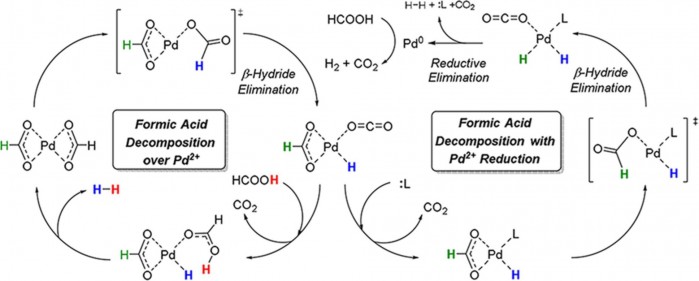댓글 쓰기 권한이 없습니다. 로그인 하시겠습니까?
Pd2+-Initiated Formic Acid Decomposition: Plausible Pathways for C-H Activation of Formate
| Journal | ChemPhysChem |
|---|---|
| Author | Won Jong Lee, Yeon Jin Hwang, Joohoon Kim, Hyangsoo Jeong, and Chang Won Yoon |
| Citation | ChemPhysChem 2019, 20, 1?11 |
| DOI | http://doi.org/10.1002/cphc.201801088 |

Formic acid (HCOOH, FA) has long been considered as a promising hydrogen-storage material due to its efficient hydrogen release under mild conditions. In this work, FA decomposes to generate CO2 and H2 selectively in the presence of aqueous Pd2+ complex solutions at 333 K. Pd(NO3)2 was the most effective in generating H2 among various Pd2+ complexes explored. Pd2+ complexes were in situ reduced to Pd0 species by the mixture of FA and sodium formate (SF) during the course of the reaction. Since C H activation reaction of Pd2+-bound formate is occurred for both Pd2+ reduction and H2/CO2 gas generation, FA decomposition pathways using several Pd2+ species were explored using density functional theory (DFT) calculations. Rotation of formate bound to Pd2+, β-hydride elimination, and subsequent CO2 and H2 elimination by formic acid were examined, providing different energies for rate determining step depending on the ligand electronics and geometries coordinated to the Pd2+ complexes. Finally, Pd2+ reduction toward Pd0 pathways were explored computationally either by generated H2 or reductive elimination of CO2 and H2 gas.
-
Read More

Highly efficient low-oxidation-potential electrochemiluminescence of ruthenium(II) complex containing selone moiety
Category2019 AuthorYoungwonJu, Hee-JunPark, Ik-SooShin, YoungKeun Chung, JoohoonKim JournalInorganic Chemistry Communications CitationInorganic Chemistry Communications Volume 106, August 2019, Pages 86-90
-
Read More

Pd2+-Initiated Formic Acid Decomposition: Plausible Pathways for C-H Activation of Formate
Category2019 AuthorWon Jong Lee, Yeon Jin Hwang, Joohoon Kim, Hyangsoo Jeong, and Chang Won Yoon JournalChemPhysChem CitationChemPhysChem 2019, 20, 1?11
-
Read More

Indium tin oxide modified with dendrimer-encapsulated Pt nanoparticles as efficient p-aminophenol redox cycling platforms
Category2019 AuthorSoon Bo Lee, Youngwon Ju, Yongwoon Lee, Joohoon Kim JournalApplied Surface Science CitationApplied Surface Science 473 (2019) 461?467
-
Read More

Single-Walled Carbon Nanotubes Decorated with Dendrimer-Encapsulated Platinum Nanoparticles as Catalytic Immobilization Matrix for Amperometric Sensing of Glutamate
Category2019 AuthorChang-Seuk Lee, Youngwon Ju, Sujin Shim, Joohoon Kim, Tae Hyun Kim JournalJournal of Biomedical Nanotechnology CitationJournal of Biomedical Nanotechnology 2019, 15, 2321-2331
Designed by sketchbooks.co.kr / sketchbook5 board skin
Sketchbook5, 스케치북5
Sketchbook5, 스케치북5
Sketchbook5, 스케치북5
Sketchbook5, 스케치북5
.png)


 Highly efficient low-oxidation-potential electroche...
Highly efficient low-oxidation-potential electroche...
 Indium tin oxide modified with dendrimer-encapsulate...
Indium tin oxide modified with dendrimer-encapsulate...